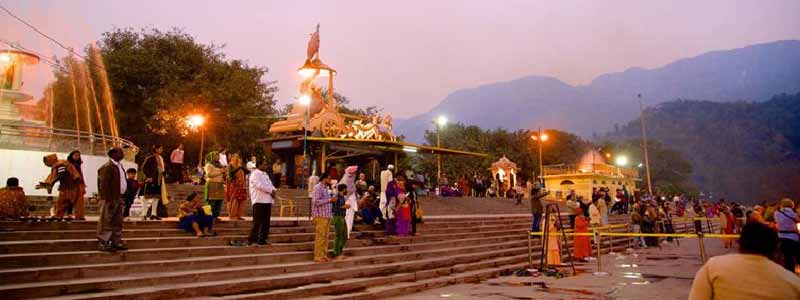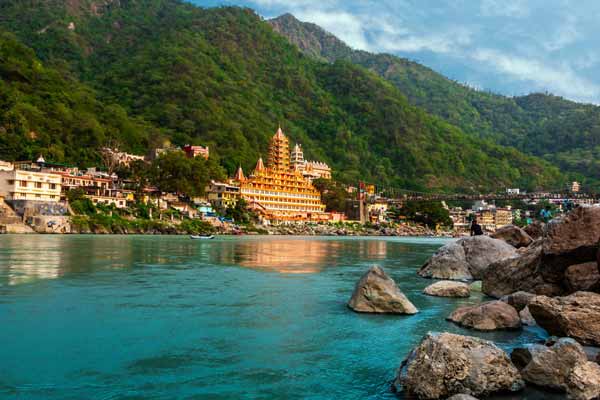Best 10 Places to Visit in Rishikesh, nestled in the foothills of the Himalayas along the banks of the sacred Ganges River, is a renowned spiritual and adventure destination in northern India. This serene town in the state of Uttarakhand has gained worldwide recognition as the “Yoga Capital of the World” and has attracted seekers, yogis, and adventure enthusiasts from every corner of the globe.
The town’s spiritual significance can be traced back to ancient times when it served as a meditative retreat for sages and saints. Today, it continues to be a hub for spiritual seekers, offering numerous ashrams, yoga centers, and meditation retreats. The tranquil environment, clean air, and the soothing sound of the flowing river make it an ideal place for self-reflection and spiritual growth.
Rishikesh is home to several iconic landmarks, including the famous Laxman Jhula and Ram Jhula suspension bridges, which are believed to be associated with Hindu mythology. The Beatles Ashram, also known as Chaurasi Kutia, is another popular attraction where the legendary band once stayed and composed music. The ashram now stands as a reminder of their transformative experience.
Adventure enthusiasts flock to Rishikesh for its thrilling activities, including white-water rafting on the Ganges, trekking in the nearby Himalayan foothills, and bungee jumping from the highest fixed platform in India. The natural beauty of the region, with lush forests, pristine rivers, and picturesque landscapes, also provides an excellent backdrop for camping and outdoor adventures.
The town hosts various festivals and events throughout the year, attracting devotees, artists, and cultural enthusiasts. The International Yoga Festival, held annually in March, is a significant event that brings together yoga practitioners, spiritual leaders, and wellness experts from around the world.
Rishikesh’s diverse cuisine caters to different tastes, offering a range of vegetarian and vegan options. The local markets are filled with unique handicrafts, jewelry, and spiritual artifacts, making it a great place for souvenir shopping Best 10 Places to Visit in Rishikesh.
In summary, Rishikesh is a multifaceted destination that offers a harmonious blend of spirituality, adventure, and natural beauty. Whether you seek inner peace, adrenaline-pumping activities, or simply a serene escape from the hustle and bustle of daily life, Rishikesh is a place that leaves a lasting impression on every visitor, Rishikesh Tour Packages.

Triveni Ghat: Nature’s Unparallel Beauty
The largest ghat in Rishikesh is Triveni Ghat. This ghat is one of the best places to visit in Rishikesh, which is close to the main market, and offers stunning views of the river and mountains. The name comes from the idea that three rivers the Yamuna, the fabled Saraswati, and the Ganges are converging here. Ghat is a set of steps that allows people to access the river for sacred bathing. At the ghat, in the evening a daily Ganges ceremony (Ganga Aarti) is held. This is a lovely location to relax on the riverbank and must place to visit in November for the perfect ambience Best 10 Places to Visit in Rishikesh.
Famous for: Spiritual Ganga aarti, meditation on the riverbank, sacred bath in holy Ganga
Timings: 9m to 8 pm
Best Time to Visit: October to April
How to Reach: Only 1.5 kilometers separate Triveni Ghat from the Rishikesh railway station. It would take about 30 minutes to walk, or you can hire a taxi or auto to reach Ghat
Ram Jhula: Soak a Panoromic View of Holy River Ganga
Ram Jhula, another architectural wonder in the nation’s capital of yoga, is a significant monument and a popular tourist destination in Rishikesh. This 450-foot suspension bridge, which connects the Ganges Riverbanks with the Shivananda and Swarga ashrams at both ends, is just 3 kilometers from the city’s center. Viewing the holy city of Rishikesh from the bridge itself while it is surrounded by the river and towering mountains is one of the most unforgettable experiences you may have at the Ram Jhula.
Famous for: Views and activities around the bridge
Best Time to Visit: Between February to May
Timings: open 24 hours
How to Reach: Nearest domestic airport is jolly Grant
Neelkanth Mahadev Temple: The Sacred Epitome of Salvation
The temple, which honors Lord Shiva, is a well-known Hindu pilgrimage destination which is considered as a main attraction in India, located 31 kilometers from Rishikesh. The most important festival observed in the temple is Maha Shivaratri, when many worshippers visit here. One of the most well-known temples dedicated to Lord Shiva is Neelkanth Mahadev Temple, which is located above Swarga ashram and next to the Nar Narayan Mountain range Best 10 Places to Visit in Rishikesh.
Famous for: Devotional offerings to lord shiva
Best Time to Visit: mid-July to mid-August
Timings: 5am to 6pm
How to Reach: Nearest station Rishikesh railway station from there you can hire a car/ taxi to reach this mystical temple
Laxman Jhula: The Iconic Landmark of Rishikesh
Rishikesh is not just about religious beliefs, ghats, or temples. This old city also has some amazing architectural wonders! One such bridge is the Lakshman Jhula, which is another among the must-see attractions and another best place to visit in Rishikesh. Lakshman Jhula is a renowned iron bridge with suspensions that crosses the Ganga within Rishikesh. The 450-foot-long bridge joins the Pauri and Tehri districts. A panoramic view of temple-filled city and the Ganges River can be seen from Lakshman Jhula .Since Lord Lakshman is thought to have crossed the Ganga at this location, it is well-known among tourists Best 10 Places to Visit in Rishikesh.
Famous for: Witnessing the fascinating waves of Ganga
Best Time to Visit: Throughout the year but October to April is suggested as best time
Timings: Any time during the day as per your convenience
How to Reach: Nearest railway station to reach Laxman jhula is Rishikesh railway station. You can also take direct buses or can reach Rishikesh by road
Shiv Puri: The Core of River Rafting
The home of Lord Shiva, Shivpuri and one of the most popular tourist attractions, is situated on the Ganges riverbank 17 kilometers from Rishikesh. It is a picturesque town in Uttarakhand, well-known for its adventurous pursuits. The most popular activities in Shivpuri are river rafting, jungle walks, mountaineering, jungle hiking, and camping. which has some of the Ganges River’s most picturesque. One of the best things to do in Rishikesh is enjoying shiv puri river rafting activities with breathtaking surroundings of Himalayan range. River rafting in Shiv puri is one of the Best 10 Places to Visit in Rishikesh.
Famous for: River rafting, jungle trekking, kayaking, bonfire camping, zip lining etc.
Best Time to Visit: February to April months and from mid-September to mid-November
Timings: Morning and afternoon shift
How to Reach: Nearest railway station to reach Shivpuri is Rishikesh railway station
Neer Garh Waterfall: Melody with Pace of Nature
This beautiful waterfall has two bridges and a few resting places with numerous varieties of butterflies that flit among the wildflowers make it very lovely. This waterfall is one of the hidden places to visit in Rishikesh and close to a short walk. The water’s naturally occurring jagged cliffs is considered as soothing. It involves a combination of ascending treks and trails along the Ganges riverbank to reach Neer Garh waterfall. Additionally, you can interact with the locals by having tea with them. Neer Garh waterfalls is one of the particular places to visit in India in the summer to take baths in the stream’s refreshing water Best 10 Places to Visit in Rishikesh.
Famous for: Trek to the waterfall, bird watching, Picnicking
Best Time to Visit: Post monsoon for amazing view of waterfall
Timings: 8am to 6pm
How to Reach: You can either hire a car to drop you off at the waterfall entrance point and hike the final 1 km through the forest, or you can trek the entire 5 km from Laxman Bridge in Rishikesh town.
Kunjapuri Devi Temple: Seek the Blessings of Goddess Sati
One of the most cherished Shakti Peeths of Goddess Shakti in the Garhwal Himalayas is Kunjapuri Devi Temple. This historic temple is situated at a height of roughly 1600 meters. The beauty of this location is that from the same hill, you can view both the Ganges River and the snow-covered Himalayas. This location is well-known for its stunning sunrise views, which feature the Sun rising from behind the Himalayan peaks. This scene is ideal for solitary retreats, yoga, and meditation Best 10 Places to Visit in Rishikesh.
Famous for: Religious observations and worshipping
Best Time to Visit: October to April
Timings: 6am to 6pm
How to Reach: The nearest railway station to reach this temple is Rishikesh. From there book a cab to reach this ancient temple.
Trayambakeshwar Temple: Majestic Temple with Architectural Grandeur
Tera Manzil Temple is a well-known landmark and a multi-Storey temple situated on the banks of the Ganga near Lakshman Jhula in Rishikesh. The Rishikesh Shiva temple, sometimes referred to as the Tera Manzil Temple and another top attractions in India, was built as Lord Shiva’s residence and is regarded as one of the numerous Jyotirlingas of Lord Shiva. Inside this 13-story Trayambakeshwar temple, one can see the exquisite patterns and architectural brilliance on the walls and idols. It is one of the Rishikesh temples that you must visit as it is thought to be older than 400 years Best 10 Places to Visit in Rishikesh.
Famous for: Precious gemstones, handicraft items, sunset view
Best Time to Visit: November to February
Timings: 6am to 7pm
How to Reach: Located near Laxman jhula, you can reach temple by walking from jhula.To reach Laxman jhula the nearest railway station is Rishikesh
Parmarth Niketan Ashram: Seek Rejuvenation at the Bank of Ganges
A wonderful spiritual retreat and a must place to visit in Uttarakhand, Parmarth Niketan is located on the revered banks of Mother Ganga in the beautiful Himalayas. It is the largest ashram in Rishikesh and provides the hundreds of pilgrims that visit with a clean, pure, and religious environment as well as an abundance of stunning flora. Near the banks of the revered Ganges River at Swargashram is where you’ll find Parmarth Niketan Best 10 Places to Visit in Rishikesh.
Famous for: Hawans and Ganga aarti on ghats of Parmarth and Ayurvedic treatment
Best Time to Visit: Late September to November
Timings: 9am to 8pm
How to Reach: Nearest railway station is Rishikesh auto and rickshaws are available from station. You can also opt for boating to cross the Ganges to reach the ashram
Beatles Ashram: Tranquilize Yourself from Within
Beatles Ashram, formerly Chaurasi Kutia, is a well-known ashram situated in Rishikesh, state of Uttarakhand adjacent to the city of Rishikesh in northern India. It is situated in the foothills of the Himalayas on the Ganges river’s eastern bank, across from Rishikesh’s Muni Ki Reti. Locals and tourists alike visit the Beatles Ashram, with the majority of visitors being fans of the band is this place is now emerging as one of the popular attractions in India. The area typically draws history historians, adventurers, peace and tranquilly seekers, nature lovers, photography aficionados, and meditation enthusiasts Best 10 Places to Visit in Rishikesh.
Famous for: Photography, meditation paintings
Best Time to Visit: October to April
Timings: 10am to 4pm
How to Reach: It is accessible by road, train, and air all at the same time. The final few km to the Ashram must be travelled on road even if you are travelling by rail or by air.
